Yet again whitetail season has come and gone. For those of us that already want to be out back in the woods, now we have an excuse! Shed hunting is a popular pastime for hunters after deer season has come to a close. Finding a nice set of whitetail sheds is super exciting. It is also a great way to really get to know the property you are going to be hunting next year. All you really need to do to find sheds is get out in the woods and start looking! However, finding sheds can be easier said than done. So here is a comprehensive guide to shed hunting for beginners with some advanced tips for experienced shed hunters as well.
What is Shed Hunting?
If you don’t know what shed hunting is, it’s when you go out looking for bucks antlers that have been “shed” hence the name. After the rut, the days start to shorten and this sends signals to whitetail that allows specialized cells to start eating away at the base of the antlers. After a while, they will fall off to make room for new antlers to grow in the coming months.
Whitetail bucks can begin to shed their antlers in January, with most bucks shedding by late April. Depending on what type of land you are on or how your deer are behaving can determine when exactly you should start shed hunting.
Do some reconnaissance, place cameras, and scout your deer. When the majority of bucks have lost their antlers it is about time to get in the woods after them. If you are on public land you might want to go in a little earlier because those sheds are going to go like hotcakes.
Questions From New Shed Hunters
1 | When Do I Start Hunting?
Well, obviously shed hunting does not have a defined season like the actual whitetail. So timing is very important. This could vary depending on if your hunting private or public land, and also what your weather is like.
If you’re on public land then you should be wary of other hunters getting out and finding sheds first. So, in this case, you might want to get out a bit earlier. Make sure to check the local deer population either by cameras or in person. If you are still seeing the majority of bucks holding their antlers then you are thinking about sheds a little too early. You want to get out there before everyone else, but if the majority of bucks have not shed yet, then you are wasting your time.
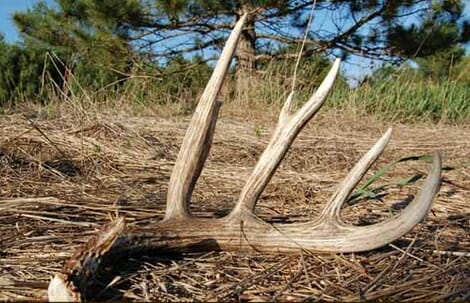
The weather also has more input than you might think. If you are farther north then you probably still have snow on the ground through January and into February. Finding sheds in snow can be super difficult and is going to hinder your success greatly. That being said if you are on private property and can afford to wait a month or two extra for the weather to clear, and for all the antlers to drop, you will likely be much more successful.
In general, I like to wait until at least mid-February until I start looking for sheds. This gives deer plenty of time to drop their antlers and keeps you from running deer to other properties where you may not have access to shed hunt.
2 | What Type of Day Is Right for Shed Hunting?
Honestly, most of us shed hunt whenever we have time, and it is not always a planned event. However, if you could pick the perfect day, it would actually be gloomy, dark, and slightly rainy.
Think about it, most of these sheds are a brown-white color. During a beautiful sunny day, they are going to blend in with everything. If the leaves are flat and the woods are a little darker then they will stand out much better. Leveraging the weather will make sheds easier to see and make you more successful.
3 | Where Do I Find Sheds?
Sheds mainly come from three places: food sources, bedding areas, and the trails in-between. If you decide to go shed hunting early, then you might want to stick to tree lines or food plots, or else you will just be rooting around in the woods spooking deer.
One great tip for hunting sheds in a food plot is to always bring binoculars. Shed hunting is a lot of walking, and if you can see farther that means you have to walk less! If you do not have any, I suggest the Bushnell® 10×42 All-Purpose Binoculars from Cabelas.com for $49.99. They are relatively cheap but are also great quality.
Related Post: Why Shed Traps Are a Bad Idea
Food Sources
Coming out of the winter months deer are packing on the pounds and will spend a sizeable amount of time around food sources. If your property has cornfields, by shed season they will be nothing but stalks. Unfortunately, sheds look a lot like corn stalks over a big field. The key to hunting sheds is to cover as much ground as possible. As the saying goes, “miles make piles”, the more ground you cover, the more sheds you will find.
Covering ground does not necessarily mean walking. You could get a height advantage and glass a 50-yard area around you. After glassing, that area for around 10 minutes moves farther down the plot.
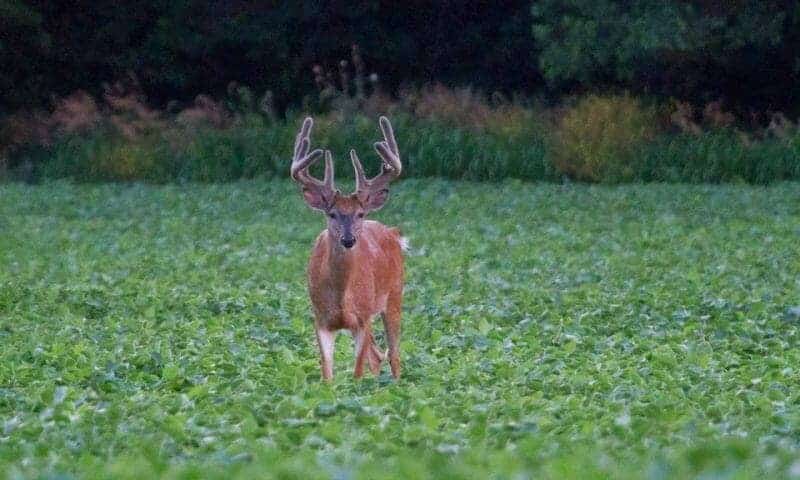
Bedding Areas
When deer are ready to bed down, the simple act of laying down and getting up throughout the day, which they do about every 30 mins, can be enough to shake those antlers off. The bad part is that deer love to bed down in the thickest areas they can find. In the middle of a brier thicket or if you are lucky maybe it is just a secluded grassy patch. If you know where the bedding areas are, you should definitely check on them when you go shed hunting.
Related Post: How to Find Buck Bedding Areas
Trails
Trails are probably the easiest way to find sheds. The trails themself are easy to find compared to the bedding locations. Chances are you already know where a good bit of trails are on your property. A good place to check is around hills or where the terrain drops down into a creek. These areas can cause the buck to produce a lot of movement which could be enough to shake off a weak antler. Some times limbs or brush can knock sheds off, or just the act of walking is enough. To be thorough make sure to go all through those trails weekly.
Fences
Similar reasoning as above, when bucks jump fences that obviously jars the deer to an extent. This leads to a high possibility that their antlers will shed. Not many hunters think of this but I have found a good amount of sheds around fences during late February and early March.
The same idea applies to creek banks. Deer cross creeks all the time, and often times it can be fairly taxing to climb up or down the side of a creek. When bucks start to shed, the act of climbing into or out of a creek can be enough to knock off their antlers.
4 | Do I Need a Shed Dog?
You do not need anything to shed hunt, except permission. But does it hurt? No way! Shed hunting dogs can be very useful. Even if you haven’t trained your dog to find sheds, just bringing them along can be a ton of fun. Actual shed dogs can be much better than you at shed hunting. So much so that they will probably find the majority of sheds.
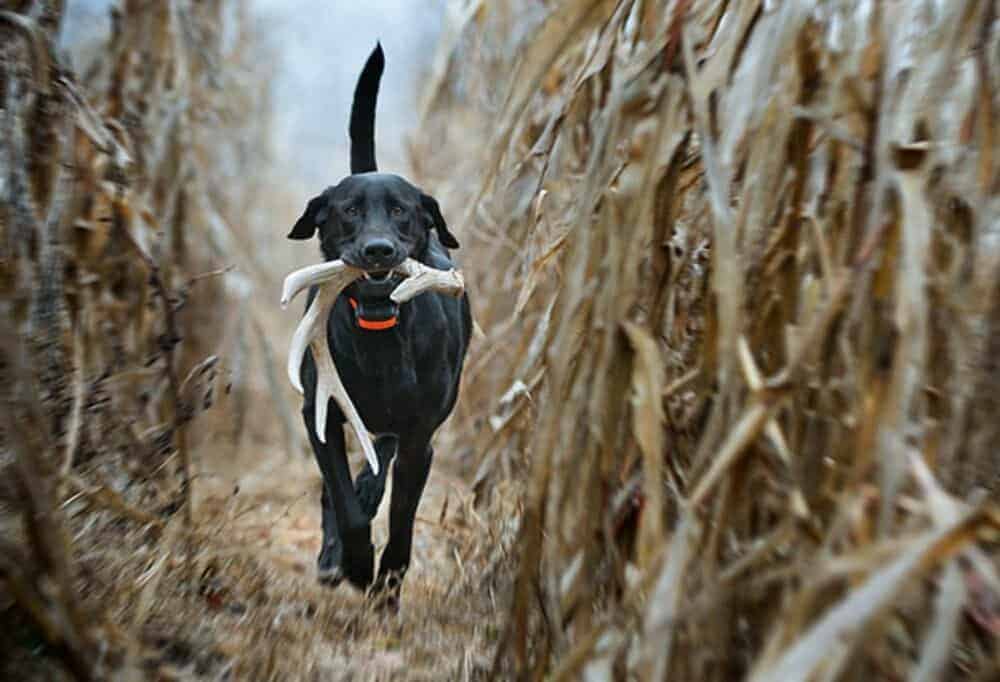
Related Post: Hunting Big Game With Dogs
Training a dog to find sheds does not take all that long. Just in 4-6 weeks, you can have your dog ready to go.
If you are thinking about which breed of dog you want to get, Labrador Retrievers are a great dog for hunting in general. They love to please and love to be in the outdoors right by your side.
Do not worry about messing up your duck dog either, other hunters that trained their duck dogs to find sheds said that it did not interfere with their performance during duck season.
Advanced Tips for Finding More Sheds
1 | Take it Slow
Like I have said before, the more ground you cover the more sheds you will find, but that doesn’t mean you should go as fast as you can. You should walk at a steady pace, slow enough to get a good look at what is around you, but fast enough to cover a lot of ground.
2 | Cover Hot Areas Twice
When you find those honey holes where deer move around a lot and spend a lot of their time, go through them twice. It is likely that you missed a shed or two. Places like bedding areas and popular food sources are the best places to go over more than once.
3 | Follow a Grid Pattern
The best way to thoroughly search your area is to use a grid pattern. While the grid pattern is simple in theory, it is very effective. This works especially well when you are going through thicker areas. In areas or trails that you can see well in, a grid pattern may not be necessary. Although if visibility is limited, or you are searching through a grassy area, a grid pattern will definitely help you find many more sheds.
The con here is that it will take you longer to cover the area, but like I said before, taking it slow and being thorough is much better than speeding through the property and not finding as many sheds.
4 | Search Rub & Scrape Lines
While rubs and scrape lines see a majority of their action during the rut and pre-rut, these areas are still social hotspots throughout the year. If there is an area on your property that generally has a lot of rubs or scrapes, that is a good indication that bucks are passing through those areas frequently throughout the year.
While bucks are more focused on feeding instead of making rubs or scrapes during this time of year, they will likely still go through the area. That makes it a great place to search for their antlers.
Related Post: Should You Hunt Rub or Scrape Lines?
5 | Check the Funnels
Funnels are great for getting deer to come right to you during the season. Although all the work you put into finding funnels and managing your property so that deer will use them does not disappear when the season ends. The deer are still going to use funnels to get from place to place because its a “funnel” they have to use it.
This also means that its a great place to look for sheds. Odds are that the majority of deer in an area are going to go through a well developed funnel, so you will have even better odds of finding sheds there compared to other places on the property.
6 | Bring Your Kids or Some Friends!
This tip is pretty simple when you think about it, the more eyes you have looking, the better chance you have of finding sheds. Plus not only are you going to have a better chance with more people, this is a great time to make some memories outdoors, especially with your kids.
Shed hunting is a great (and safe) way to introduce your kids to the outdoors, and teach them what you know about it. Plus they will be super excited when they find their first shed.
What if You Can’t Find Sheds?
Some times it does not matter if you walk 100 miles, if there are no sheds to be found, you will not find any! Although this may not be the worse thing ever. Just because you find a whitetail shed, does not mean that that deer lives on your property during the fall.
We want bucks on the property during the hunting season in the fall, so if they are on other properties during the rest of the year it is not a problem! As long as you can attract them during the fall, and your property is the most attractive during the fall, that is what truly matters.
Here is what Jeff Sturgis from Whitetail Habitat Solutions has to say about not finding sheds:
Never Use a Shed Trap!
One thing I want to stress before we wrap up this post is how terrible shed traps are. While it sounds like an awesome idea, no matter how you build a shed trap, it can be very harmful to deer.
Related Post: Why Shed Traps Are a Bad Idea
Basically a shed trap consist of some sort of bait and some sort of object that knocks off or catches loose antlers. Here is an example of a shed trap:
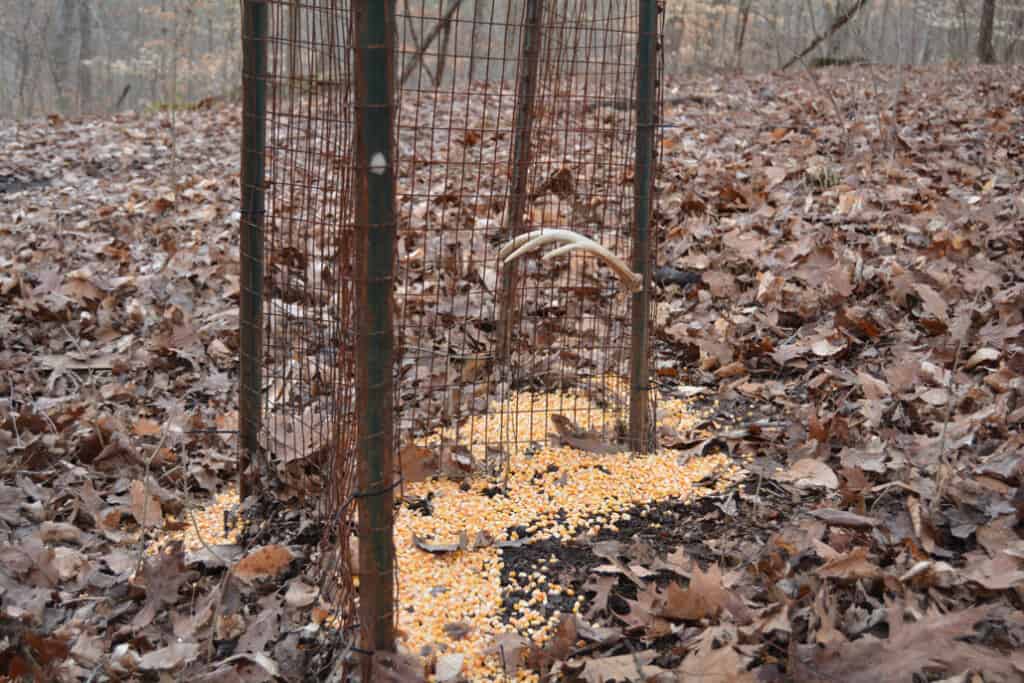
When hunters use shed traps, they risk damaging the buck’s pedicle. If you damage a pedicle, it is literally like ripping away part of the buck’s skull. When a pedicle is damaged, the best-case scenario is a deformed antler for a few years. The worst case is a brain abscess, which can be deadly. Bucks can damage their pedicles naturally through fighting and this can be one of the most common non-human causes of death among older bucks.
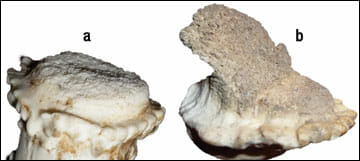
For example A above, you can see how it is clean and smooth. This is what we would expect from a normal shed. Although, in example B you can see how much a portion of the pedicle was broke off with the antler. This injury can have lasting effects. A small pedicle injury may not be deadly; although, an injury as large as example B will have a lasting effect for years to come and has a high chance of leading to a brain abscess. The deformity that this will cause will affect not only the looks of the buck but also his ability to fight other bucks during the rut. So even if you use an antler trap and managed to get the sheds from your number one buck that you just missed this year, congratulations, you just messed up his rack for life. Not to mention, his chances of breeding are significantly decreased.
Sister Post – 10 Essential Items for Shed Hunting
Now that you know what shed hunting is all about, you should get ready to get out there and find some sheds! But what should you take with you? To answer that question I have written another post titled “10 Essential Items For Shed Hunting”. Check it out here, or read a sample of it below:
Be Prepared With the Right Shed Hunting Gear
Regardless of what you are doing in the woods, you should always be well prepared. Not only so you can get the most out of your trips but also to keep you and others safe. A lot of gear is not a requirement to get be outdoors, and the gear you get certainly does not have to be expensive. Although, if you use the right shed hunting gear, you can improve your success at the sport.
10 Ideal Pieces of Shed Hunting Gear
1| Backpack – Carrying Your Shed Hunting Gear
Bringing a good backpack may be the most important item on this list. Hopefully, you find a lot of sheds, but you need to be able to carry them! Several different kinds of backpacks will work, so… Keep Reading
….
5| Hiking Boots – Miles Make Piles
Another one of the most important pieces of your shed hunting gear is a pair of good hiking boots. In shed hunting, miles make piles, so the best way to find a lot of sheds is to cover a lot of ground. Hiking boots can make or break this experience. Comfort is not the only important metric though… Keep Reading
Thank you for reading my article about shed hunting. I hope you enjoyed it and learned something you didn’t already know. If you like my content, subscribe to my weekly update. If you have any other questions about shed hunting tips or just want to connect, feel free to email me at [email protected].

